Side Menu:
Second Officer C.H.Lightoller - Resignation and Publicity
With the end of the war, White Star Line ships were gradually transitioned back into passenger liners. At first Lightoller was listed as a standby for the Vedic, from 29th of January 1919 to the 26th of February 1919. And then finally he was appointed Chief Officer on the Celtic, serving aboard her for one year from the 26th of February 1919 until the 14th of February 1920.
Lightoller is listed as Chief Officer of the Celtic on three Eliis Island immigration documents for arrival into New York during 1919:
S.S. Celtic, 17th May 1919, Chief Officer, 43 yrs old, 5ft 7in, 180lbs
S.S. Celtic, 13th July 1919, Chief Officer, 42 yrs old, 5ft 9in, 168lbs
S.S. Celtic, 22nd October 1919, Chief Officer, 49 yrs old, 5ft 10in, 120lbs
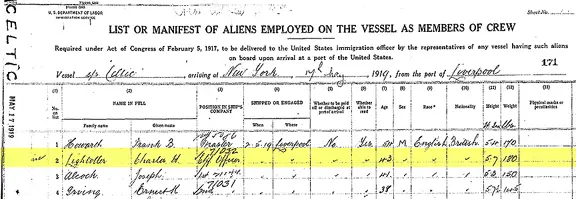
Ellis Island immigration document for the S.S. Celtic's entry into New York. Lightoller is listed as Chief Officer, 43 years old, 5ft 7inches, 180lbs. (Click image to enlarge)
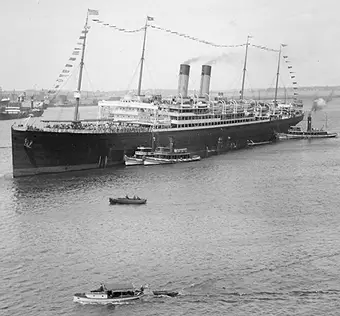
RMS Celtic - Lightoller's last White Star Line ship
which he served aboard as Chief officer.
(Click to enlarge)
Although at first, as chief officer, it seemed a promotion from his last position with the White Star Line, the Celtic was an older, smaller ship, sailing out of Liverpool (not Southampton) and he had been passed over for positions on the Olympic, Homeric and the Majestic II. Hence, the Celtic became his last ship, an irony considering it held a place in his heart:
“There used to be a fine picture in the front of old Todd and Whall’s Seamanship (a book familiar to all apprentices) when first I went to sea. It was a picture of the S.S. Celtic, the old Celtic of the White Star Line, driving her way to westward. A big fourmaster with twin funnels and somehow I got to look on her as the height and summit of my ambition. Years passed. Ships came and ships went. Now one Company and now another. Off on the trail and back to sea. The war blazed up and burned out. Yet it was a curious coincidence that for my last ship I should find myself in the modern edition of my boyhood’s ambition; the R.M.S. Celtic. And it was in my cabin on board this ship that I finally wrote my resignation and said good-bye to the Sea.”(47.)
As a result, Lightoller decided to leave merchant shipping altogether and on February 6, 1920, he submitted his resignation to the White Star Line and on the 14th of February 1920, Lightoller had officially resigned.
Furs, faith, yachts and chickens

Lightoller was a Christian Scientist and
wrote several articles in the Christian Science
Monitor during the 1920s.
Herbert's first venture, importing Canadian furs, fell apart after funds proved to be insufficient to keep the business going. So he ended up becoming a British political correspondent for the weekly newspaper The Christian Science Monitor in the 1920s. He had already written four articles published in the Christian Science Sentinel, on Titanic and his experiences during the war so perhaps it was a natural progression.
He then converted their Pimlico home into a guest house, which proved so successful that the Lightollers eventually were able to purchase a small vacation home in Port Victoria along the River Medway.
When they moved to Putney, Lightoller encountered a ship-builder by the name of Charlie Cooper, and in 1929 Charles’s life long desire to own a family-sized yacht became realised when he bought for £40 (equivalent to £2,000 today) and converted a motor yacht which he named Sundowner. The hull was discovered by Sylvia who was looking for a cruising yacht and recovered from the mud at Conyer Creek east of the River Medway and was fitted with two masts and ketch-rigged with jib, mainsail, mizzen and mizzen staysail. Lightoller renamed the vessel from Hobo to Sundowner in honour of his Australian wife (in Australia, a hobo who tends to enter town at sunset is known as a 'sundowner'). The Sundowner was originally an Admiralty steam launch built in 1912 and 52 feet long and during her 1929 refit was extended to 58 feet.
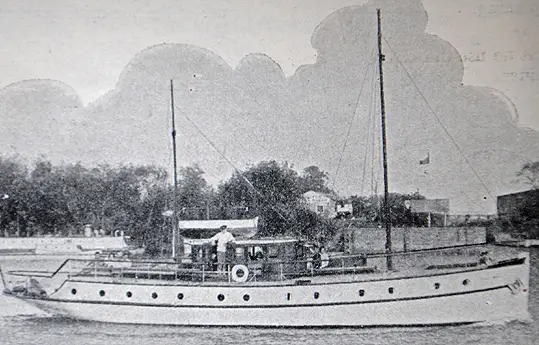
Lightoller aboard his converted motor yacht, the Sundowner.
(Click image to enlarge)
The Sundowner was launched on 28 June 1930, and after trials on the Thames, undertook her first voyage to France and became a beloved part of the Lightollers’ holiday routine. During the next ten years the Lightollers cruised along the northern coast of Europe, taking part successfully in many international competitions. In 1936 Lightoller replaced the engine with a more powerful 72 hp (54 kW) single screw, Gleniffer diesel engine giving her an extra 2 knots (3.7 km/h; 2.3 mph), so it could achieve 10 knots (19 km/h; 12 mph).
In 1931 the family moved from Putney to Cockfeathers, in the northeast of London, where Lightoller tried his hand at raising chickens. Initially, they sold eggs to local retailers, and it turned out that he was surprisingly well-suited for poultry farming.(61.)
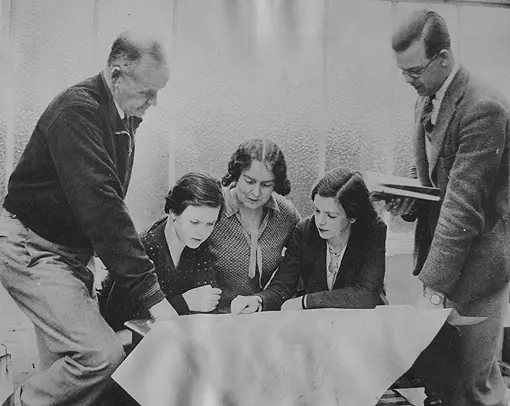
Lightoller with family in 1933. From left: Herbert Lightoller, daughter Mavis, wife Sylvia Lightoller, daughter Doreen and son Trevor (Click image to enlarge)
Memoirs and controversy
In 1934, apparently at the urging of his wife Sylvia, Herbert Lightoller wrote and in 1935 published his memoirs, a book he entitled "Titanic and Other Ships".
Lightoller (right) with family in the year he wrote his memoirs 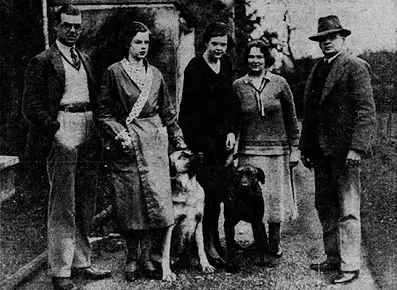
- 1934 - at family’s estate in Hadley Woods, near London.
(Click to enlarge)
It is in many ways a poetic, dramatic and anecdotal book. But for the historian it is rather self-absorbed, lacking in specifics and with questionable accuracy. For example it is missing the names of many of the "other ships" or uses completely fictional names such as the "SS Niagara" which he describes on the African Mail Service run. Not only does a ship of that name not exist but it is not on his BOT records, indicating either a faulty memory or deliberate fictionisation. He also makes some rather common errors, such as naming the ship that almost collided with Titanic as she departed Southampton as the "St Paul" instead of the "New York". Perhaps it is not a major error but it does show a flippant attitude to accuracy.
There is also inconsistency between his Titanic inquiry evidence and the description in his book. For example, in Chapter 33, he says he met all of the engineers as they trouped up from below. However, on page 90 of the US Inquiry, he said:
Mr. LIGHTOLLER. "All the engineers and other men and many of the firemen were down below and never came on deck at all.
Senator SMITH. They never came on deck?
Mr. LIGHTOLLER. No, sir; they were never seen.(25.)
Further, the book contains almost comically over dramatic life and death stories that sometimes beggars belief. Either a case of very bad luck or dramatic license, or perhaps a mix of both.
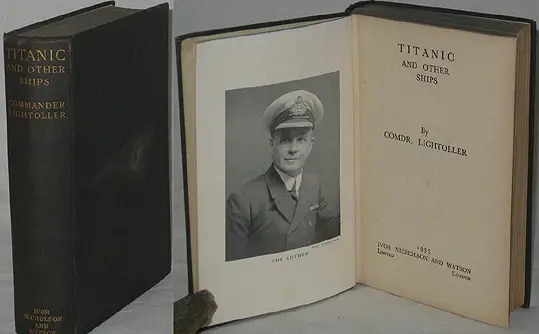
First Edition hardcover edition of Lightoller's book "Titanic and Other Ships", dated January 1935. (Click image to enlarge)
More disappointingly, he rarely mentions his wife and does not say how or when they met and allows no insight into how he juggled his career and family life.
Its release was not without controversy. In his book Lightoller had pinpointed wireless operator Jack Phillips not passing on the Mesaba ice warning to the bridge as causing a delay that "proved fatal and was the main contributory cause to the loss of that magnificent ship and hundreds of lives." Lightoller writes that he was told this by Phillips himself when they sought refuge on the upturned collapsible B, before Philips died. He describes the moment: "He hung on till daylight came in and we sighted one of the lifeboats in the distance . . . . he suddenly slipped down, sitting in the water, and though we held his head up he never recovered. I insisted on taking him into the lifeboat with us." (47.)
However there is an issue with this account. Firstly, according to Archibald Gracie, who wrote his account in 1912, Lightoller at the time did not believe it was Phillips. Gracie writes:
"Among the number, we are told by Bride and Whiteley, was the senior Marconi operator, Phillips, but their statement that it was Phillips' lifeless body which we transferred first to a lifeboat and thence to the Carpathia is a mistake, for the body referred to both Lightoller and myself know to have been a member of the crew, as described later . . . . When the presence of the Marconi boy at the stern [i.e. Harold Bride] was made known, Lightoller called out, from his position at the bow, questions which all of us heard, as to the names of the steamships with which he had been in communication for assistance. We on the boat recall the names mentioned by Bride . . . . When my turn came [to transfer from the collapsible to the lifeboat] I went carefully . . . . Lightoller remained to the last, lifting a lifeless body into the boat beside me . . . . He was dressed like a member of the crew . . . . Lightoller was uncertain as to which one he was of two men he had in mind; but we both knew that it was not the body of Phillips, the senior Marconi operator." (43.)
Gracie also refers to Lightoller's 1912 inquiry testimony and quotes it as follows: "I think there were three or four who died during the night aboard our boat. The Marconi junior operator told me that the senior operator was on this boat and died, presumably from the cold." [Gracie, p. 98. (43.)]
According to author George Behe and his article "The Fate of Jack Phillips" it is unlikely that Phillips was on collapsible B at all. He writes: "As with so much of Lightoller's 1934 information, however, his latter-day claims about Jack Phillips are contradicted elsewhere and must be taken with a huge grain of salt... By 1934, however, Second Officer Lightoller's story had become much more elaborate; by that time his conversation with Harold Bride on board the collapsible had 'changed' into a conversation with Jack Phillips, and the body of the dead crewman had changed into the body of Phillips himself." (Source: http://wormstedt.com/GeorgeBehe/Page13.htm)
At the time of the publication of the book, his account of the Mesaba message and Phillip's alleged failure did indeed cause controversy. His wife Sylvia Lightoller wrote a letter to Walter Lord congratulating him on his book "A Night to Remember" in 1955 and wrote: "Did you know when my husband's book Titanic and Other Ships was published it was withdrawn as they were threatened with a libel action because he told the truth about Philips and the delayed message. We only got about £15 out of the copies sold! " (courtesy of Paul Lee, http://www.paullee.com/titanic/slightoller.html)
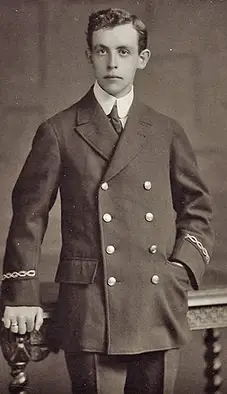
Second wireless operator Harold Bride.
However there is no record of libel action. There is a record of the surviving wireless operator Harold Bride challenging Lightoller's portrayal, when an abridged version of Lightoller's book was serialised in the Dundee "Evening Telegraph" in January 1936. On January 15th, 1936, Bride's letter appeared, saying that "Phillips ... was one of the most skillful and experienced operators then in the service of the Marconi Company. At the Board of Trade inquiry...no proof was available that the "Mesaba" message was ever received by the Titanic. Had it been received, I say with all sincerity that Jack Phillips would have realised its importance and immediately communicated it to the bridge, for the mysteries of latitude and longitude were not confined to navigating officers. If Commander Lightoller knew all about the "Mesaba message", as he claims, why did he not say so at the Board of Trade Inquiry, and not wait until this late day to throw doubts on the efficiency of a very gallant gentleman who died procuring aid for Commander Lightoller and 701 other fortunate survivors? ... [Phillips efficiency] does not go with putting urgent ice warnings under paper weights and promptly forgetting them." (courtesy of Paul Lee, http://paullee.com/titanic/icewarnings.php)
Lightoller himself replied to Bride's criticism on January 29th in the Dundee Evening Telegraph, defending his Mesaba account. He writes:
"I do not wish to open any controversy or attribute the slightest blame to any individual for the Titanic disaster… I tried to pay full tribute to the coolness and courage exhibited by the passengers and crew of the Titanic though their magnificent behaviour was actually beyond all praise. I endeavoured to set forth as clearly as possibly my wholly dispassionate and unbiased view of the circumstances surrounding that tragic night, including the events leading up to the loss of that magnificent ship. I yet maintain, as officer of the watch from 8 to 10pm, that night, and in further defence of that splendid officer, W.M.Murdoch, who followed me on watch from 10pm to the moment of the collision, that had the Mesaba message been received by the bridge, and in reasonable time, the Titanic would not have been lost… In conclusion, and in what I hope may prove to be the last I shall ever write of that unforgettable tragedy…I am trying to correct wrong impressions only…I blame no one and justify no one. Captain Smith, Murdoch and Phillips played their parts as men living up to the highest traditions of the sea, and all three finally made the great sacrifice. Let no man question but that they acted up to their very highest ideals in that supreme tragedy - the loss of the Titanic."
For the full transcript of the Harold Bride complaint and Lightoller rebuttal please check this article here.
While Lightoller once again emphasised the importance of not receiving the Mesaba message in his BBC radio broadcast later that year it is interesting to note that two different versions of the books appeared, from the original 1935 Ivor Nicholson and Watson edition, to the 1939 Bay Tree paperback edition, with subtle changes made to the Mesaba account. Most notably it omitted the sentence that also implicated Bride as an accomplice in failing to take the Mesaba message to the bridge: "That he received the message is known, and it was read by the other operator in his bunk."
In reality Lightoller's emphasis on the Mesaba ice warning is a moot point. Indeed the officers, including Lightoller himself who had made ice position calculations, knew there was ice ahead. It was not knowledge of ice ahead that was ever the issue; it was the failure to take any action over that information that ultimately caused a tragedy.
There are also rumors that as Lightoller maligned White Star in his book, the publisher pulled and shredded the remaining hardcovers to prevent a lawsuit. However as the book was rereleased four years later in 1939 in paperback format, with some slight revisions to his comments on the Marconi operators, this rumour seems unlikely.
Blue Peter and BBC radio broadcast
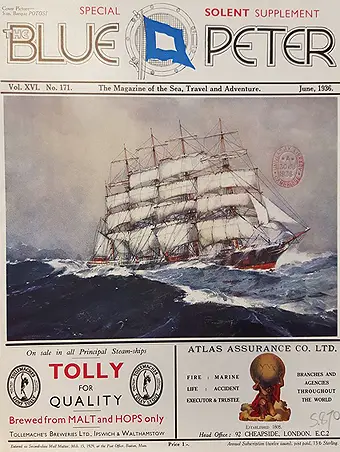
A year after releasing his memoirs, Lightoller also made a radio appearance and wrote an article. Entitled "The Man on the Bridge" by Commander Lightoller, the article appeared in the June 1936 "The Blue Peter" magazine devoted to "Sea, Travel and Adventure". A full transcript of the article can be viewed here
The article was likely written in response to the maiden voyage of the RMS Queen Mary a month before, on the 27th May 1936. His overall message seems to be that no matter the size or technological advancement in shipbuilding, the overall safety of the ship relies on the experience and instinct of "The Man on the Bridge." He uses two very curious incidents to prove this, neither of which instills confidence. The first involving a near grounding of an "Atlantic greyhound" in fog due to Lightoller mistaking the echo of their whistle as another ship. And the second a botched lowering of a lifeboat in a display before royalty. Considering that Lightoller was officer of the watch during the estimations of approaching ice aboard Titanic and also mismanaged the lowering of lifeboats during the portside evacuation, these are curious moments to retell indeed. And even more interesting, perhaps, is the acknowledgement at the end of the article that "as speed increases, so the seconds available for what may be, perhaps, a life and death decision decrease." A truth that he never admitted in relation to Titanic.
Then later in the year he appeared in a November 1st 1936 BBC broadcast entitled "I Was There" allowing us to hear him describe his Titanic experience in his own words, with his noticeable Lancashire accent.
A full transcript and video of this broadcast can be viewed here.
Note: I recommend watching the film in "Full Screen Mode," with speakers/headphones turned on for the full experience. To activate "Full Screen Mode," you need to click on the video title which will take you to YouTube and then click on the lower right hand box.
It is a very similar retelling to his book. He begins with "Altogether I have had four shipwrecks and a fire. During my 30 odd years at sea, but by far and away the worst of them all was the one I'm going to tell you about now: the loss of the Titanic." and also adds at the end a poignant moment in which the survivors on the upturned collapsible pray the "Our Father" saying "I don't think it was exactly scare that made everyone join in. But you'd need to be in somewhat the same fix. Where a couple of minutes may mean all the difference between well here and Hereafter. to understand the feeling we put into it. I've heard that prayer ever since I was a child, but never with such intense earnestness, as the surroundings lent to it that night. "